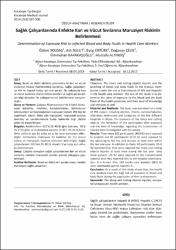Sağlık çalışanlarında enfekte kan ve vücut sıvılarına maruziyet riskinin belirlenmesi
Özet
Amaç: Kesici ve delici aletlerle yaralanma ile kan ve vücut
sıvılarının mukoz membranlara sıçraması, sağlık çalışanları-
na HIV ve hepatit bulaşı için risk yaratır. Bu çalışmada kan
ve vücut sıvılarına maruz kalma oranları ve sağlık personelinin
bilgi düzeyleri ile yaklaşımlarının belirlenmesi amaçlanmıştır.
Gereç ve Yöntem: Çalışma Afyonkarahisar’da 5 farklı hastanede
doktorlar, internler, hemşire/ebeler, laboratuvar
teknisyenleri ve hastabakıcıları kapsayan toplam 298 kişi ile
yapılmıştır. Kesici, delici alet maruziyeti, maruziyet sonrası
davranış ve yaralanmalarla bulaş hakkında bilgi düzeyi
anket ile araştırılmıştır.
Bulgular: Katılımcıların 122’si (% 40,9) iğne batması, 83’ü
(% 27,9) göze ve mukozalara sıçrama ile 80’i (% 26,8) kesici
delici aletlerle son bir yılda en az bir kere maruziyet bildirmiştir.
Kontamine materyale 63 katılımcı (% 21) maruz
kalmış ve maruziyeti hastane idaresine bildirmiştir. Sağlık
çalışanlarının 265’inin (% 88,3) Hepatit B’ye karşı aşılı oldu-
ğu belirlenmiştir.
Sonuç: Çalışma sonuçları sağlık çalışanlarının kan ve vücut
sıvılarına mesleki maruziyet riskinin yüksek olduğunu göstermiştir. Objective: The sharp and cutting objects injuries and the
splashing of blood and body fluids to the mucous membranes
create the risk of transmission of HIV and hepatitis
in the health care workers. The aim of this study is to determine
the rates of exposure to the blood and the body
fluids of the health personnel and their level of knowledge
and attitudes as well.
Material and Methods: The study was examined on a total
of 298 people including doctors, interns, nurses/midwifes,
laboratory technicians and caregivers in the five different
hospitals in Afyon. The exposure of the sharp and cutting
objects, the behaviour of the participants after exposure
and the level of knowledge regarding the transmission of
injuries were investigated with the survey.
Results: There were 122 participants (40,9 %) were exposed
to pinprick and 83 participants (27,9 %) were exposed to
the splashing to the eye and mucosa at least once within
the last one year. In addition to them, 80 participants (26,8
%) reported that, they were exposed the sharp and cutting
objects injuries at least once during the last year. Sixty
three persons (21 %) were exposed to the contaminated
material and they reported this to the hospital administration.
It is known that, 265 health care workers (88,3 %)
were vaccinated against hepatitis B.
Conclusion: As a result of this study shows that, the health
care workers have the high risk of exposure to blood and
body fluids during the application of their professionals.
Kaynak
Afyon Kocatepe Üniversitesi, Kocatepe Tıp DergisiCilt
15Sayı
3Bağlantı
http://hdl.handle.net/11630/2131Koleksiyonlar
- Makaleler [452]
- TR-Dizin İndeksli Yayınlar Koleksiyonu [241]



















